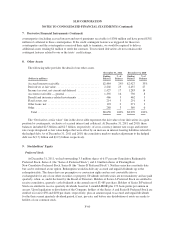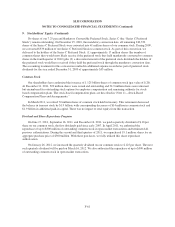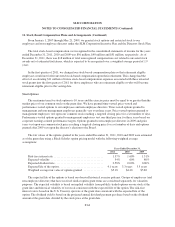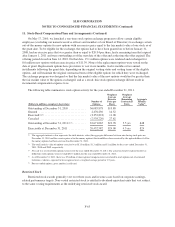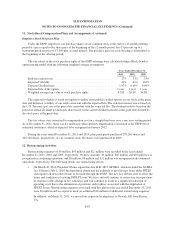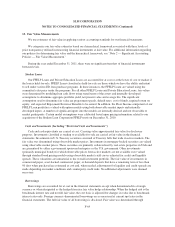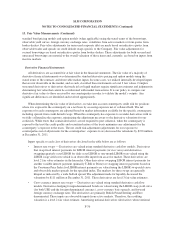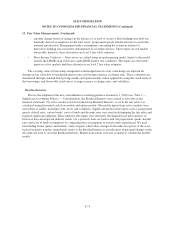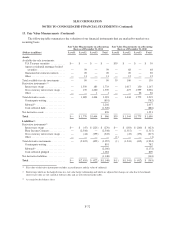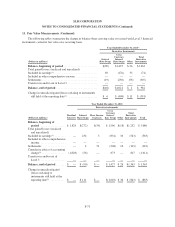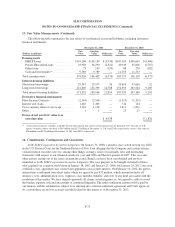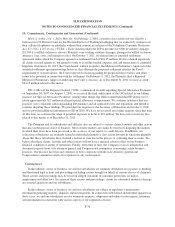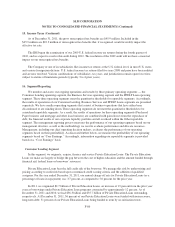Sallie Mae 2011 Annual Report Download - page 179
Download and view the complete annual report
Please find page 179 of the 2011 Sallie Mae annual report below. You can navigate through the pages in the report by either clicking on the pages listed below, or by using the keyword search tool below to find specific information within the annual report.SLM CORPORATION
NOTES TO CONSOLIDATED FINANCIAL STATEMENTS (Continued)
13. Fair Value Measurements (Continued)
standard bond pricing models and option models (when applicable) using the stated terms of the borrowings,
observable yield curves, foreign currency exchange rates, volatilities from active markets or from quotes from
broker-dealers. Fair value adjustments for unsecured corporate debt are made based on indicative quotes from
observable trades and spreads on credit default swaps specific to the Company. Fair value adjustments for
secured borrowings are based on indicative quotes from broker-dealers. These adjustments for both secured and
unsecured borrowings are material to the overall valuation of these items and, currently, are based on inputs from
inactive markets.
Derivative Financial Instruments
All derivatives are accounted for at fair value in the financial statements. The fair value of a majority of
derivative financial instruments was determined by standard derivative pricing and option models using the
stated terms of the contracts and observable market inputs. In some cases, we utilized internally developed inputs
that are not observable in the market, and as such, classified these instruments as level 3 fair values. Complex
structured derivatives or derivatives that trade in less liquid markets require significant estimates and judgment in
determining fair value that cannot be corroborated with market transactions. It is our policy to compare our
derivative fair values to those received by our counterparties in order to validate the model’s outputs. Any
significant differences are identified and resolved appropriately.
When determining the fair value of derivatives, we take into account counterparty credit risk for positions
where it is exposed to the counterparty on a net basis by assessing exposure net of collateral held. The net
exposures for each counterparty are adjusted based on market information available for the specific counterparty,
including spreads from credit default swaps. When the counterparty has exposure to us under derivatives with us,
we fully collateralize the exposure, minimizing the adjustment necessary to the derivative valuations for our
credit risk. While trusts that contain derivatives are not required to post collateral, when the counterparty is
exposed to the trust the credit quality and securitized nature of the trusts minimizes any adjustments for the
counterparty’s exposure to the trusts. The net credit risk adjustment (adjustments for our exposure to
counterparties net of adjustments for the counterparties’ exposure to us) decreased the valuations by $190 million
at December 31, 2011.
Inputs specific to each class of derivatives disclosed in the table below are as follows:
• Interest rate swaps — Derivatives are valued using standard derivative cash flow models. Derivatives
that swap fixed interest payments for LIBOR interest payments (or vice versa) and derivatives
swapping quarterly reset LIBOR for daily reset LIBOR or one-month LIBOR were valued using the
LIBOR swap yield curve which is an observable input from an active market. These derivatives are
level 2 fair value estimates in the hierarchy. Other derivatives swapping LIBOR interest payments for
another variable interest payment (primarily T-Bill or Prime) or swapping interest payments based on
the Consumer Price Index for LIBOR interest payments are valued using the LIBOR swap yield curve
and observable market spreads for the specified index. The markets for these swaps are generally
illiquid as indicated by a wide bid/ask spread. The adjustment made for liquidity decreased the
valuations by $111 million at December 31, 2011. These derivatives are level 3 fair value estimates.
• Cross-currency interest rate swaps — Derivatives are valued using standard derivative cash flow
models. Derivatives hedging foreign-denominated bonds are valued using the LIBOR swap yield curve
(for both USD and the foreign-denominated currency), cross-currency basis spreads, and forward
foreign currency exchange rates. The derivatives are primarily British Pound Sterling and Euro
denominated. These inputs are observable inputs from active markets. Therefore, the resulting
valuation is a level 2 fair value estimate. Amortizing notional derivatives (derivatives whose notional
F-70


